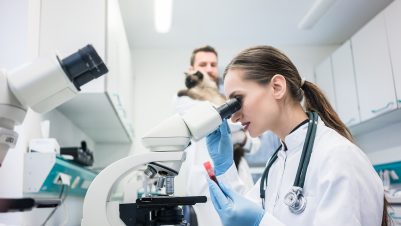In this communication we present a brief review and a case report on fungal dermatitis in a bearded dragon. We received a 6.5cm right foreleg of a one-year-old male bearded dragon. It had well-demarcated dark yellow-to-brown focally extensive ulcers on the dorsal and palmar aspect of the leg, each approximately 1cm long. The underlying skin was thickened. After decalcifying it, we processed it for histopathology examination.
The microscopic findings in the skin were as follows: severe orthokeratotic hyperkeratosis with multiple underlying extensive ulcers characterised by numerous septate, branching non-parallel wall fungal hyphae, admixed with degenerated heterophils, bacteria aggregates and cellular debris immersed in an amorphous eosinophilic material (Figure 1). The remaining epidermis had similar fungal hyphae within the stratum corneum. The underlying dermis was severely infiltrated by numerous heterophils and macrophages, fewer lymphocytes and well-demarcated granulomas that also contained numerous hyphae, epithelioid macrophages and multinucleated giant cells (Figures 2 and 3). Similar inflammatory infiltrate and microorganisms were also extending into muscle and bone, including bone marrow and joints (Figure 4).




The morphologic diagnosis was granulomatous and necrotising dermatitis, cellulitis, myositis and osteomyelitis (severe), with intralesional fungal organisms. Culture would be necessary to identify the agent. Among the possible aetiologies, Chrysosporium sp. is considered the most likely cause of these findings.
Discussion
Fungal infections of reptiles have been regarded as opportunistic, caused by saprophytic organisms and often associated with inappropriate environmental conditions, poor nutrition or immunosuppression. Mycoses may be classified as phaeohyphomycosis or hyalohyphomycosis on the basis of the presence or absence, respectively, of pigment in the cell wall of the causative fungus. In this case there was no evidence of pigmented microorganisms.
The main pathogens which might cause these findings in bearded dragons are fungi of the genera Nannizziopsis, Paranannizziopsis and Ophidiomyces. Among them the Chrysosporium anamorph of Nannizziopsis vriesii (CANV) is the most important clinically, and is the primary pathogen responsible for “yellow fungus disease”, an emerging disease in reptiles. There is strong anecdotal evidence to suggest that CANV is highly contagious among bearded dragons.
Most cases have been identified in reptiles: bearded dragons as in this case, but also snakes, geckos, lizards and saltwater crocodiles. However, related Chrysosporium species have been documented in other species, such as C. pannicola in dogs, horses and humans, C. tropicum in chickens and C. keratinophilum and C. zonatum in humans. Nannizziopsis guarroi has also been also reported to be associated with a necrotising dermatitis in captive green iguanas (Iguana iguana) and bearded dragons (Pogona vitticeps) across both Europe and North America.
In bearded dragons, this fungus causes granulomatous dermatitis which often extends into underlying muscle and bone causing myositis and osteomyelitis, as in this case. It often progresses to lethal systemic infection, affecting internal organs where it also causes granulomatous infections.
Fungal infections are likely underdiagnosed as they are often difficult to clinically differentiate from bacterial infections, which are more common. The key for the diagnosis is skin biopsy and culture. It is important to bear in mind that this fungus is difficult to identify on culture as it may be mistaken for Trichophyton, Geotrichum, Malbranchea and Trichosporon. Therefore, it is important to inform the lab of any suspicion of Chrysosporium infection when submitting a biopsy for culture.
| At NationWide Laboratories we are committed to making a positive impact on animal health by offering innovative products, technology and laboratory services to your veterinary practice. We have been providing a comprehensive range of veterinary diagnostic services since 1983. Our expert teams assist you in making decisions on relevant testing for companion, exotic and farm animals. We offer full interpretation in a range of testing areas including biochemistry, haematology, cytology, histopathology, endocrinology, microbiology, etc. Our sample collection service is powered by National Veterinary Services. For more updates, follow NationWide Laboratories on LinkedIn and Twitter, visit our website or join us in our interactive online learning hub. Please come to say hello to us at our stand D302 at BSAVA Congress 2022 in Manchester! |








